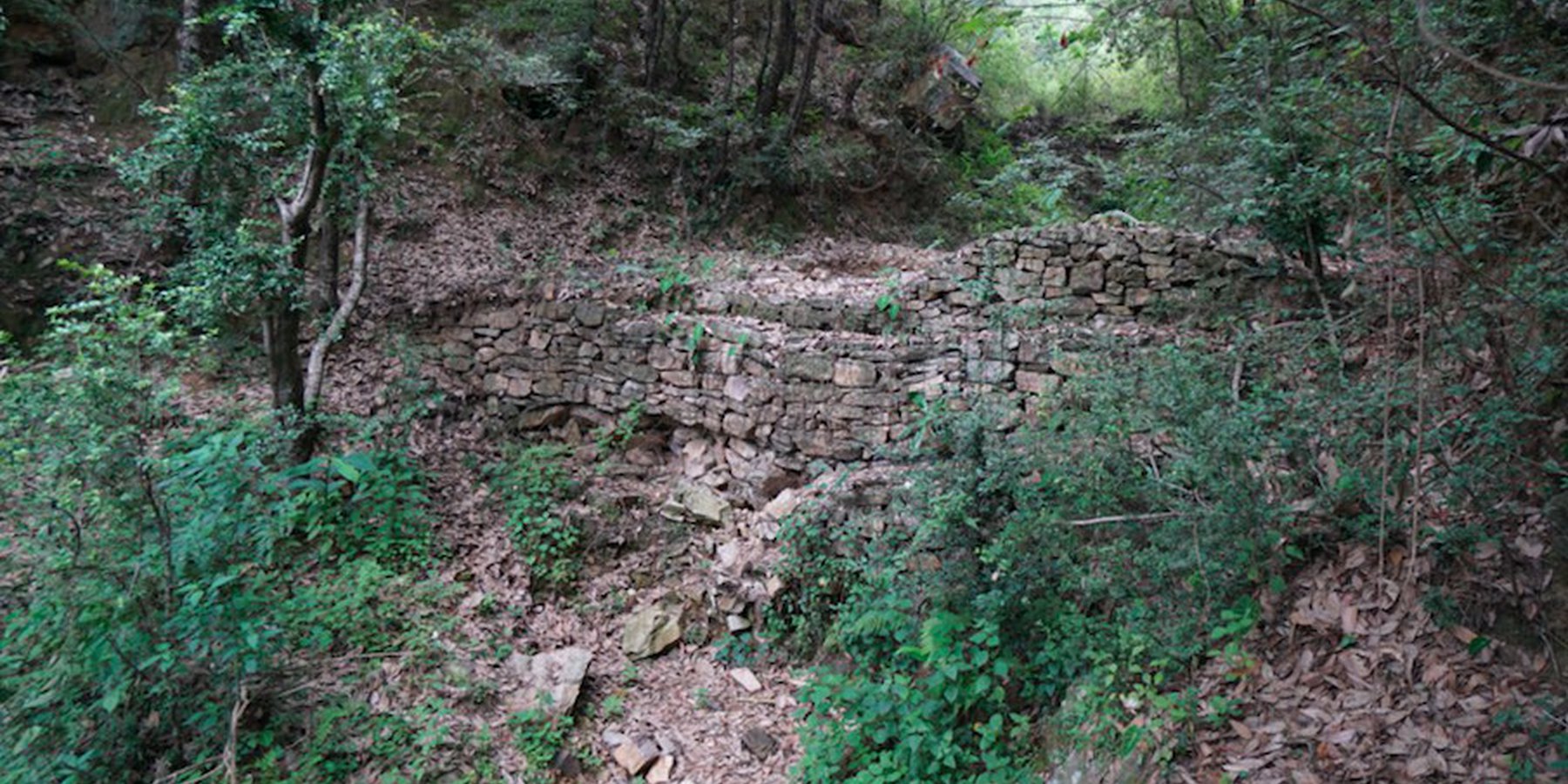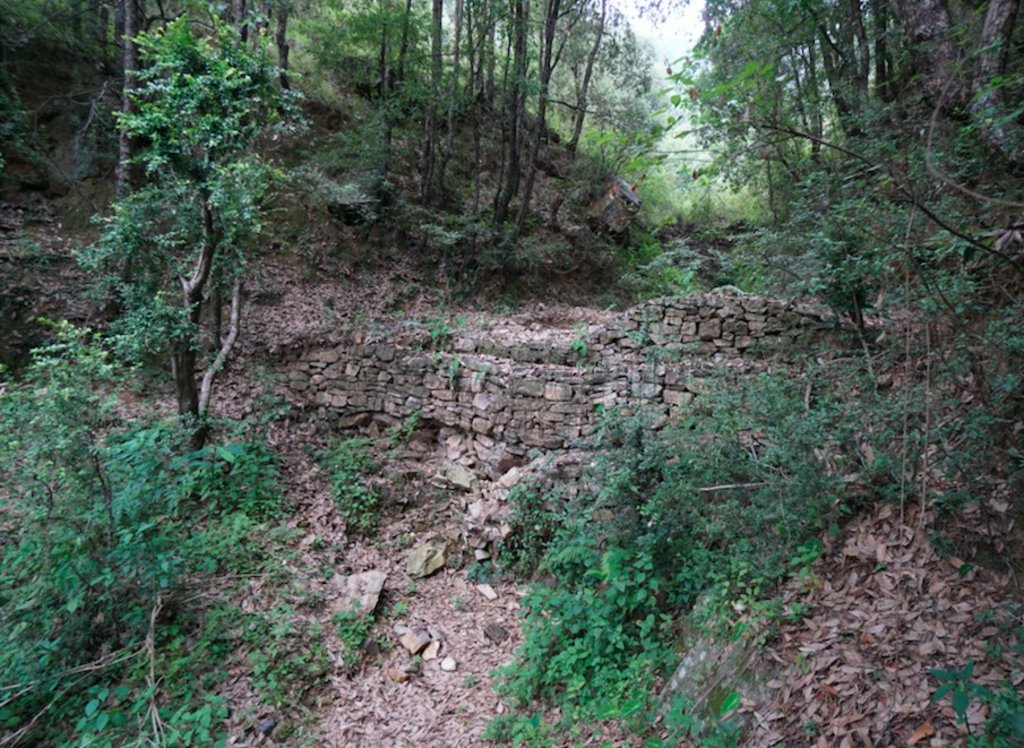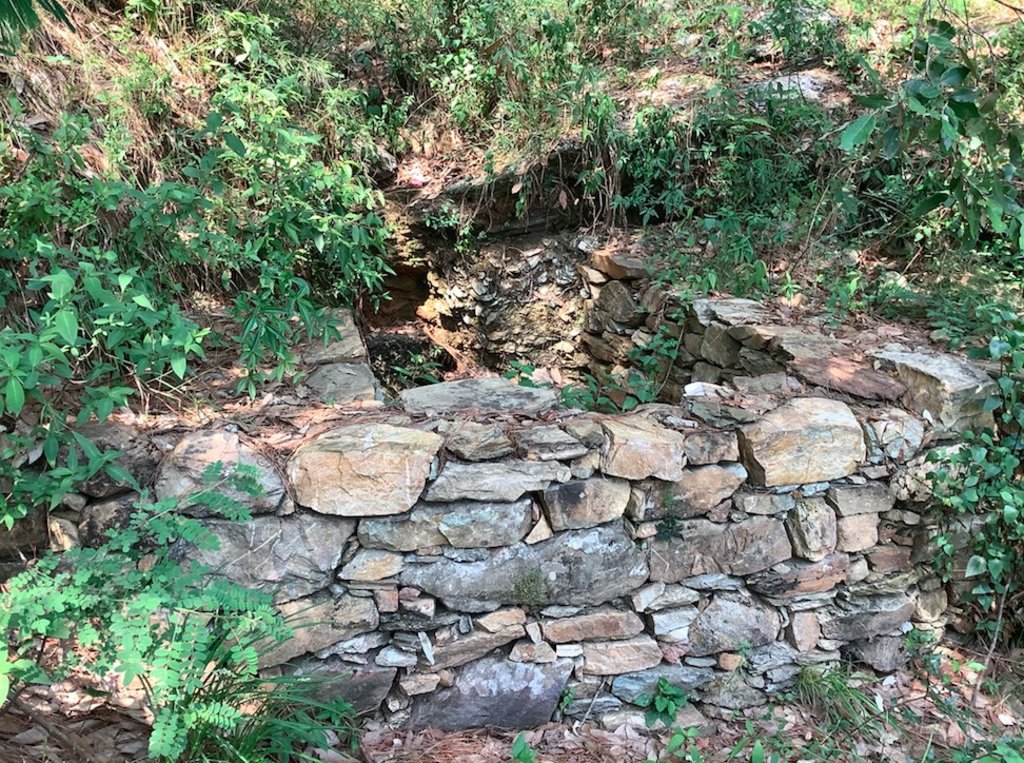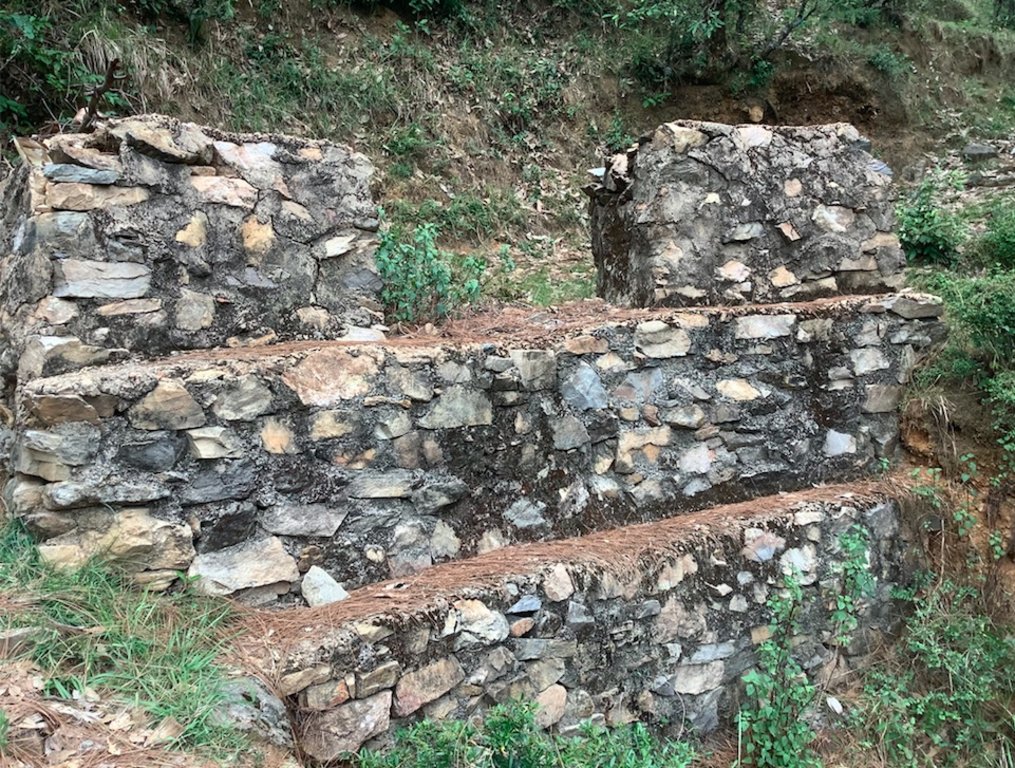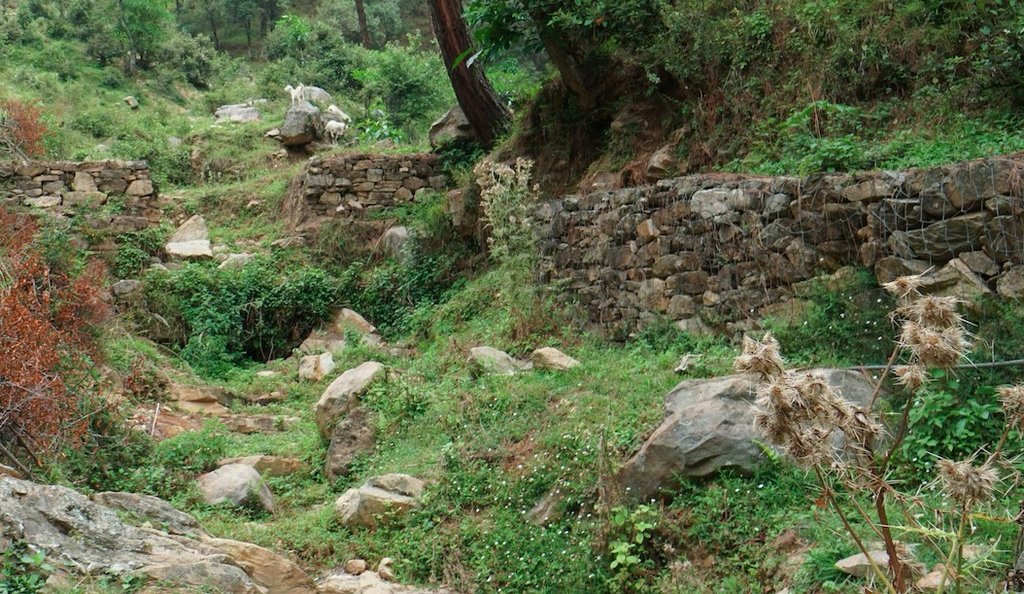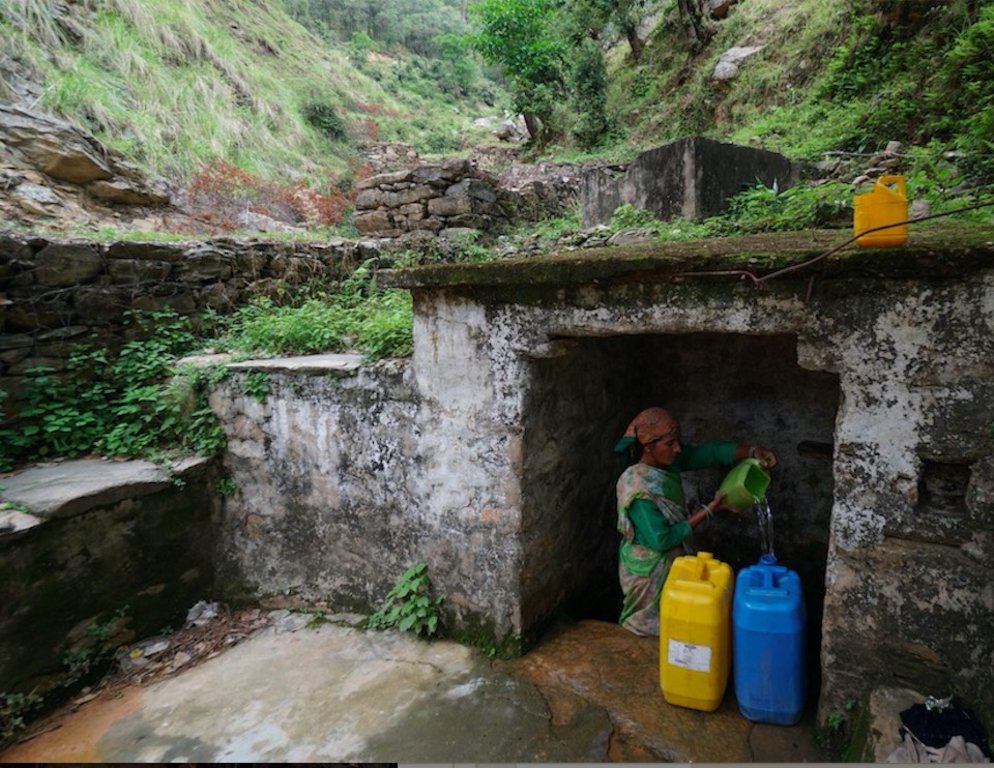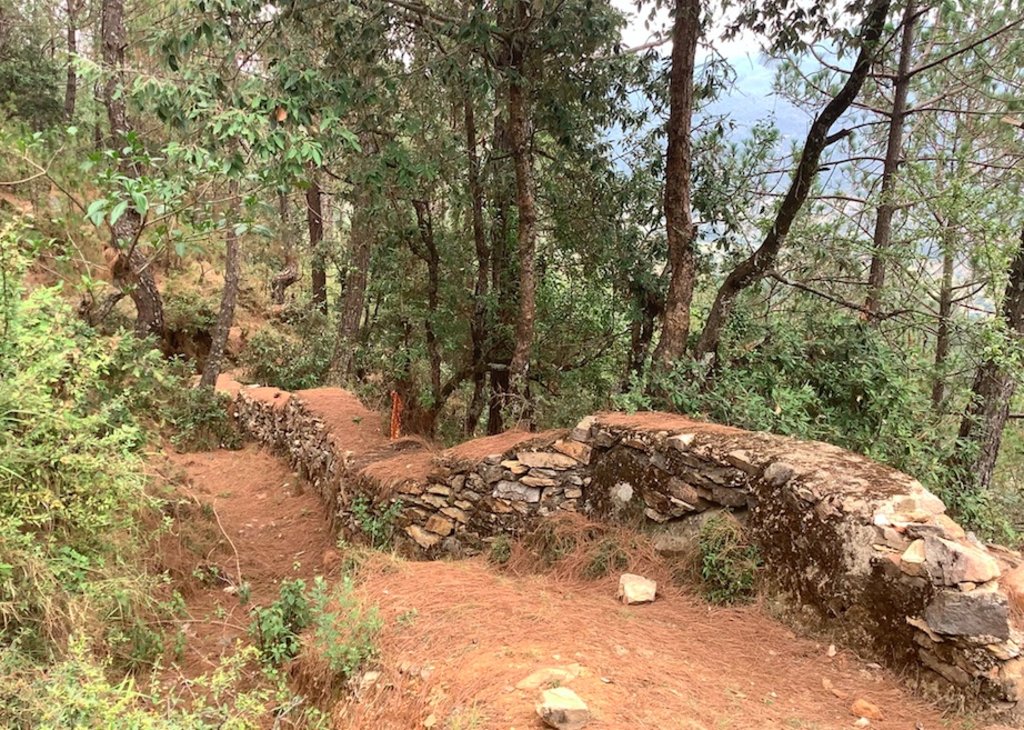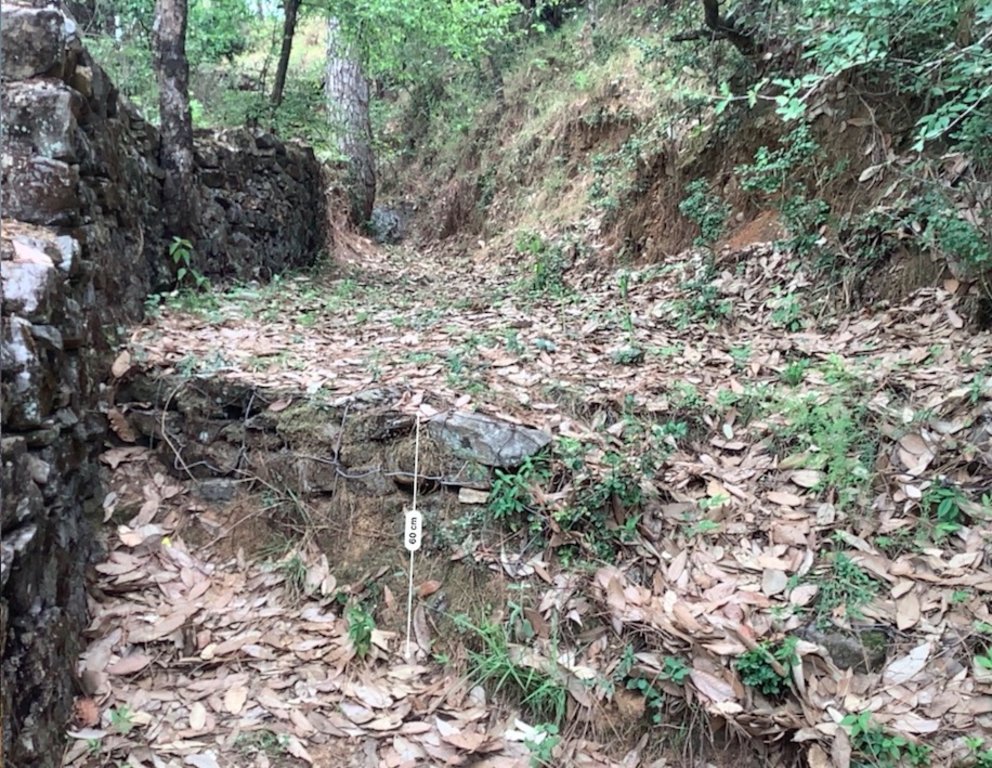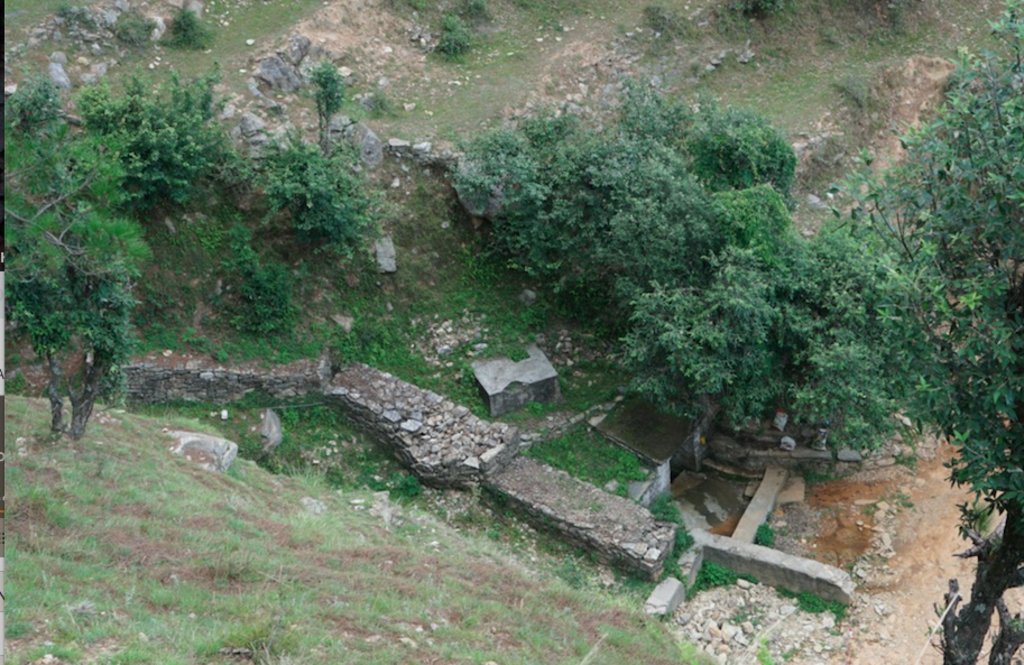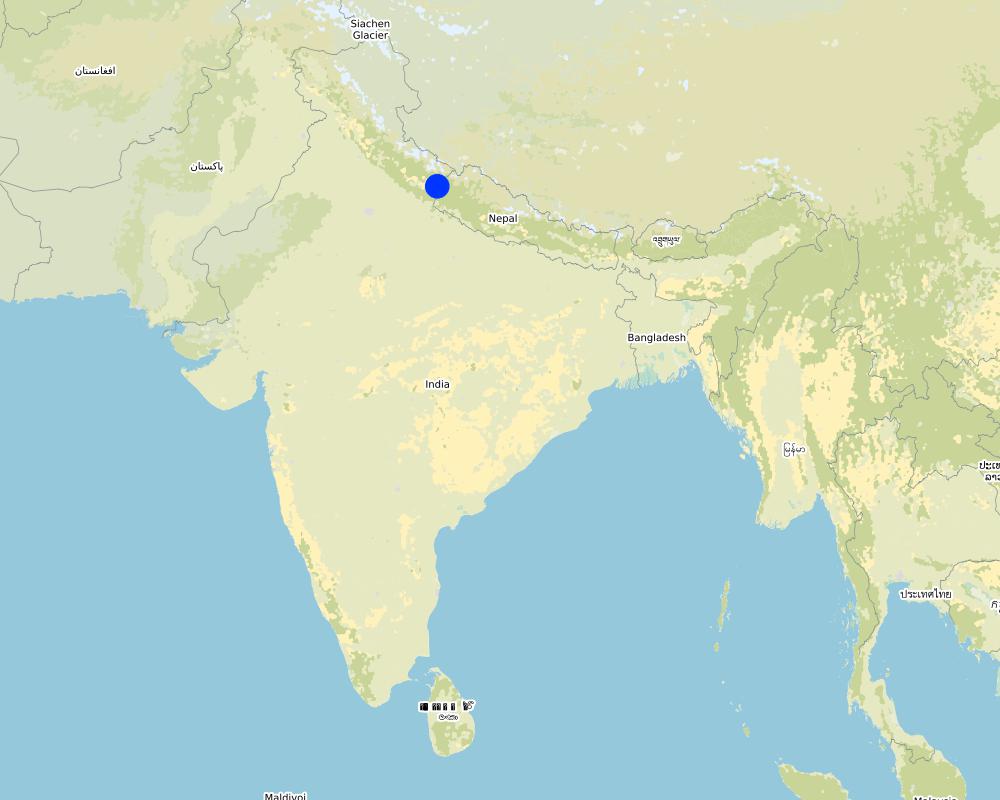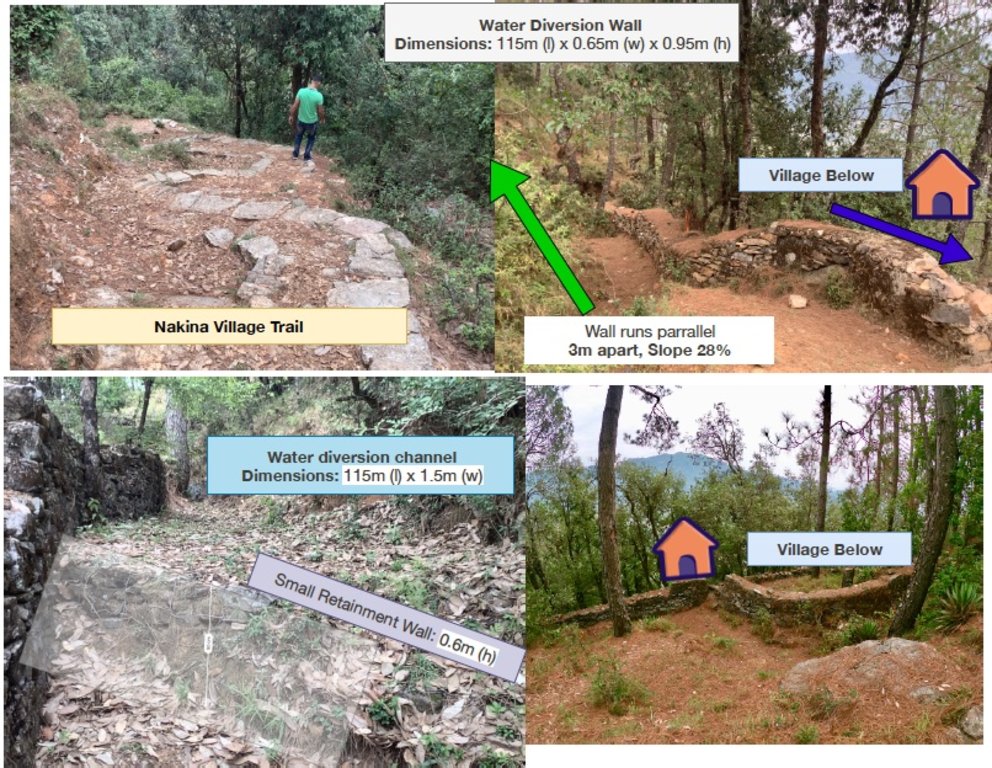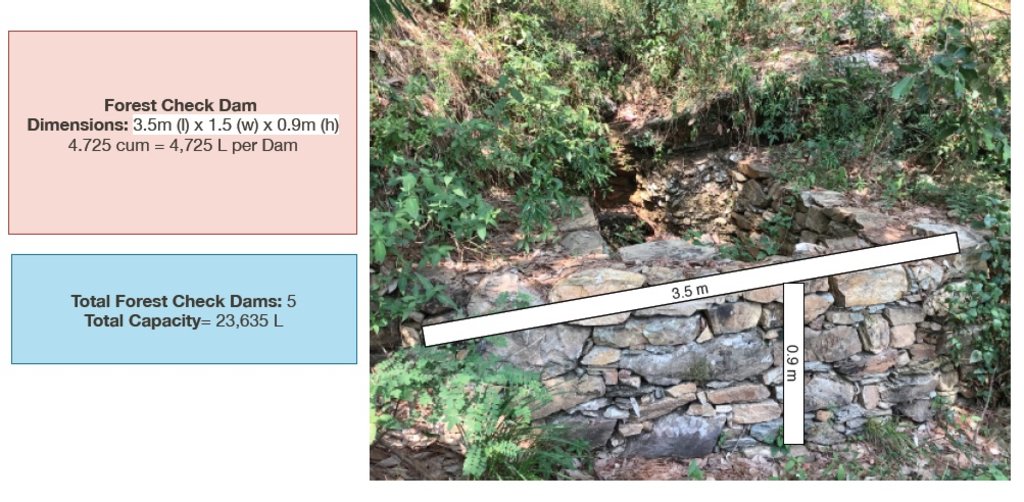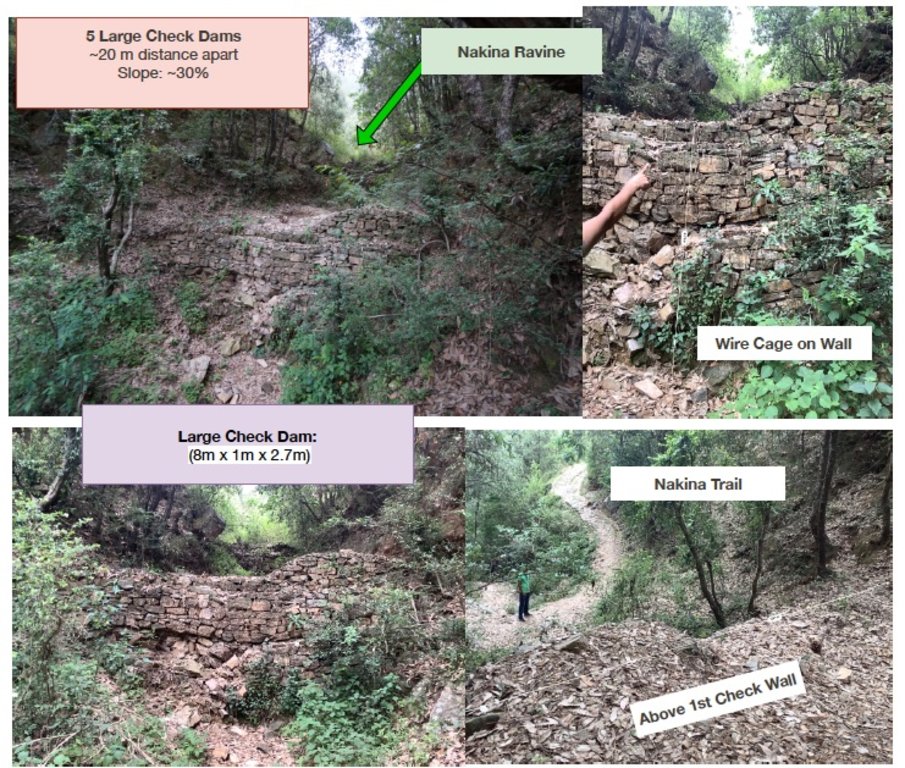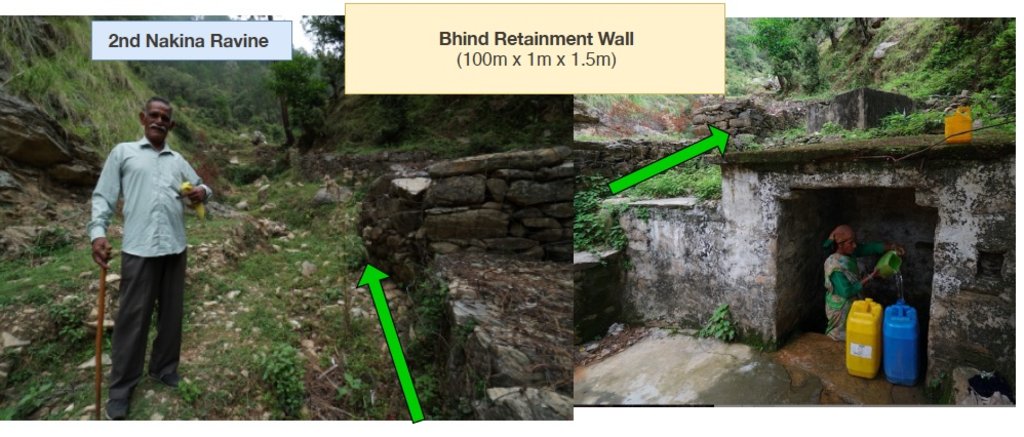Stone Check Walls and Check Dams for Soil and Water Conservation [India]
- Creación:
- Actualización:
- Compilador: Jaclyn Bandy
- Editor: –
- Revisor: Hanspeter Liniger
technologies_5210 - India
Visualizar secciones
Expandir todo Colapsar todos1. Información general
1.2 Detalles de contacto de las personas de referencia e instituciones involucradas en la evaluación y la documentación de la Tecnología
Persona(s) de referencia clave
usuario de la tierra:
Jagdamba Joshi
Nakina Village
India
Nombre del proyecto que financió la documentación/ evaluación de la Tecnología (si fuera relevante)
Onsite and Offsite Benefits of SLMNombre de la(s) institución(es) que facilitaron la documentación/ evaluación de la Tecnología (si fuera relevante)
ICIMOD International Centre for Integrated Mountain Development (ICIMOD) - NepalNombre de la(s) institución(es) que facilitaron la documentación/ evaluación de la Tecnología (si fuera relevante)
G.B. Pant Institute of Himalayan Einvironment & Development (G.B. Pant Institute of Himalayan Einvironment & Development) - India1.3 Condiciones referidas al uso de datos documentados mediante WOCAT
El compilador y la/s persona(s) de referencia claves aceptan las condiciones acerca del uso de los datos documentados mediante WOCAT:
Sí
1.4 Declaración de la sostenibilidad de la Tecnología descrita
¿La Tecnología aquí descrita resulta problemática en relación a la degradación de la tierra, de tal forma que no puede considerársela una tecnología sostenible para el manejo de la tierra?
No
1.5 Referencia al (los) Cuestionario(s) de Enfoques MST (documentados usando WOCAT)
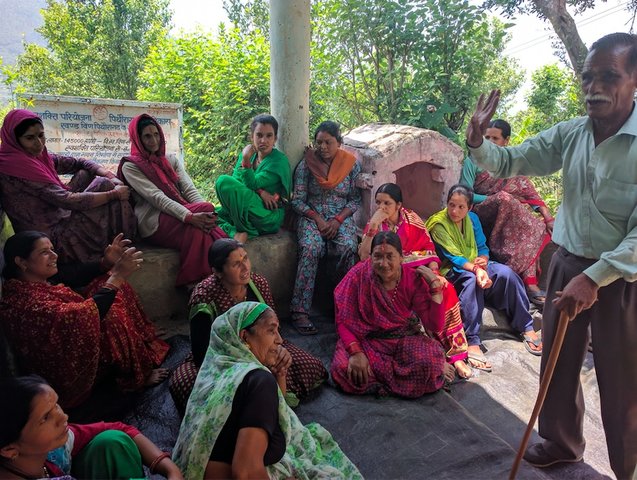
Community Forest Management in the Nakina Van Panchayat [India]
Van Panchayats or village forest councils are a impressive example of grassroots community management of natural resources, where a specific administrative unit is locally elected by community members who are responsible for the management of activities related to the forest.
- Compilador: Jaclyn Bandy
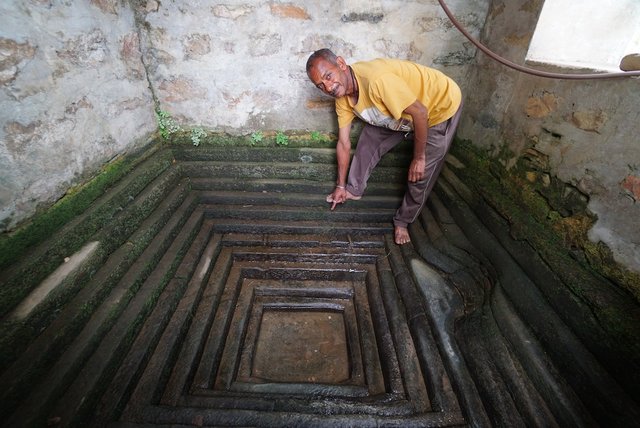
Naula Management and Conservation [India]
Naulas are shallow, four-sided stepped wells designed to collect water from subterranean seepages or springs and are used to meet domestic water needs by the local communities. Naula management and conservation encompasses a range of activities that preserve their structure and function.
- Compilador: Jaclyn Bandy
2. Descripción de la Tecnología MST
2.1 Breve descripción de la Tecnología
Definición de la Tecnología:
Stone Check Dams/Walls, Retainment Walls, and a Water Diversion Wall has been constructed in Nakina Village and Nakina Community Forest to help protect their settlements, agriculture land, forest land, and preserve the hilly landscape. These structures serve to reduce the runoff velocity (lowering the rate of erosion and gullying in steep slope channels) and increase infiltration for groundwater recharge.
2.2 Descripción detallada de la Tecnología
Descripción:
1. The technology is found in both natural and human environments (forest and settlement areas)
2. Main Characteristics: A check dam or check wall is constructed in a loose or active gully or a rill (shallow channel) that threatens to enlarge, or anywhere on a slope where there is a danger of scour from running water. The structures lower the velocity of flow. In Nakina porous check walls, check dams, and retainment walls were made out of stone gathered from the surrounding area. A porous check dam releases a portion of flow through the structure, decreases the head of flow over the spillway, and decreases the dynamic and hydrostatic forces against the check dam. Porous check dams are simple and more economical for construction.
Once stones are collected they are cut into suitable sizes and surfaces ( "dressing" of stones). The site where the technology is to be constructed is then cleared and, for check dams, the sides are sloped 1:1 (this simply refers to the ratio of the rise and run of the slope, so 1:1 means you'll have a 45 degree slope for your excavation). This is also known as the angle of repose, where the granular material of the embankment will be stable and not slump from its own weight. The base of the dam should be around 70 cm thick if it is 1 meter high. The bed of gully is excavated for foundation and dry stones are packed from that level.
3. Purposes/functions: Interrupts the flow of water and flattens the gradient of a channel, thereby reducing the velocity and inducing infiltration rather than eroding the channel. These structures not only slow flow velocity but also to distribute flows across vegetation. Despite some sedimentation resulting behind the dam, small cracks and porous spaces in the holes of the stones allow some sediment to flow through and the finer particles fill the gaps and strengthen the structure. Check dams can also be designed to create small reservoirs.
4. Major activities include identifying the appropriate site of installation, collection of construction materials, technical planning of the structure dimensions and design, manual labor, and maintenance.
5. Benefits/impacts: These structures decelerate runoff and accelerates groundwater recharging by storing water and facilitating infiltration of water into the soil
6. Like/Dislike:
Advantages
•Inexpensive and relatively easy to install given local building materials and labor availability
•Reduce velocity, prevent gully erosion and cause a high proportion of the sediment load in runoff to settle out, preventing downstream damage
•When carefully located and designed, check dams can remain as permanent installations with very minor regrading
Disadvantages
•Many of these structures have a temporary nature, and need to reconstructed or removed after significant damage
•Removal or reconstruction may be a significant cost depending on the size and design
•May kill grass linings in channels if the water level remains high after rainstorms or if there is significant sedimentation.
•May create turbulence which erodes the channel banks.
•Clogging by organic material may be a problem and hinder the structure's function
2.3 Fotografías de la Tecnología
2.5 País/ región/ lugares donde la Tecnología fue aplicada y que se hallan comprendidos por esta evaluación
País:
India
Región/ Estado/ Provincia:
Uttarakhand
Especifique más el lugar :
Nakina Village, Pithoragarh Bloc
Especifique la difusión de la Tecnología:
- aplicada en puntos específicos/ concentrada en un área pequeña
¿El/los sitio(s) de la Tecnología se ubica(n) en un área de protección permanente?
Sí
Si fuera el caso, especifique :
5 check dams are located in the protected forest of Nakina. The other structures are located in the village settlement (the 5 check walls are within the ravine) or just above the Bhind Spring (Naula).
Map
×2.6 Fecha de la implementación
Si no se conoce el año preciso, indique la fecha aproximada:
- hace más de 50 años atrás (tradicional)
2.7 Introducción de la Tecnología
Especifique cómo se introdujo la Tecnología:
- mediante la innovación de usuarios de tierras
- como parte de un sistema tradicional (> 50 años)
- mediante proyectos/ intervenciones externas
Comentarios (tipo de proyecto, etc.):
Check dams and other retainment structures are technologies that have been used for centuries. Some of the structures in the village are nearly +50 years old and have either been constructed with the help of the government (ravine check dams in settlement and above Bhind Naula) and others have been more recently constructed by the villagers themselves to support the forest landscape, specifically springshed recharge.
3. Clasificación de la Tecnología MST
3.1 Propósito(s) principal(es) de la Tecnología MST
- reducir, prevenir, restaurar la degradación del suelo
- conservar el ecosistema
- proteger una cuenca hidrográfica/ áreas corriente abajo – en combinación con otras Tecnologías
- reducir el riesgo de desastres naturales
- adaptarse al cambio climático/ extremos climáticos y sus impactos
3.2 Tipo(s) actuales de uso de la tierra donde se aplica la Tecnología

Bosques
- Bosques/ zonas boscosas (semi) naturales
Bosques/ zonas boscosas (semi-) naturales: Especifique tipo de manejo:
- Tala selectiva
Tipo de bosque (semi)natural:
- vegetación natural de bosque subtropical seco
- quercus leucotrichophora (Banj oak)
¿Los árboles especificados son deciduos o imperecederos?
- deciduo
Productos y servicios:
- Madera
- Leña
- Pastoreo/ ramoneo
- Conservación/ Protección de la naturaleza

asentamientos, infraestructura
- Asentamientos, edificios
3.3 ¿Cambió el uso de tierras debido a la implementación de la Tecnología?
¿Cambió el uso de tierras debido a la implementación de la Tecnología?
- No (Continúe con la pregunta 3.4)
3.4 Provisión de agua
Provisión de agua para la tierra donde se aplica la Tecnología:
- de secano
3.5 Grupo MST al que pertenece la Tecnología
- medida de pendiente transversal
- diversión y drenaje de agua
- manejo de agua superficial (manantial, río, lagos, mar):
3.6 Medidas MST que componen la Tecnología

medidas estructurales
- S3: Acequias graduadas, canales, vías fluviales
- S6: Muros, barreras, vallas, cercas
3.7 Principales tipos de degradación del suelo encarados con la Tecnología

erosión de suelos por agua
- Wt: pérdida de capa arable/ erosión de la superficie
- Wg: erosión en cárcavas
- Wm: movimiento de masas / deslizamientos de tierra
- Wr: erosión de riberas
- Wo: efectos de degradación fuera del sitio

deterioro físico del suelo
- Ps: hundimiento de suelos orgánicos, asentamiento del suelo

degradación biológica
- Bc: reducción de la cobertura vegetal del suelo
- Bq: reducción de la cantidad/ biomasa

degradación del agua
- Hg: cambio en nivel de aguas subterráneas/ nivel de acuífero
3.8 Prevención, reducción o restauración de la degradación del suelo
Especifique la meta de la Tecnología con relación a la degradación de la tierra:
- prevenir la degradación del suelo
- reducir la degradación del suelo
4. Especificaciones técnicas, actividades de implementación, insumos y costos
4.1 Dibujo técnico de la Tecnología
4.2 Información general sobre el cálculo de insumos y costos
Especifique cómo se calcularon los costos e insumos:
- por unidad de Tecnología
Especifique unidad:
1. Small Check Dams 2. Large Check Walls 3. Water Diversion Wall 4. Bhind Check Walls/Retainment wall
Especifique las dimensiones de la unidad (si fuera relevante):
1. 5 units (3.5m x 1.5m x 0.9m) 2. 5 units (8m x 1m x 2.7m) 3. 1 unit (115m x 0.65 x 0.95m) 4. 1 unit (100m x 1m x 1.5m)
otra / moneda nacional (especifique):
INR
Si fuera relevante, indique la tasa de cambio de dólares americanos a la moneda local (ej. 1 U$ = 79.9 Reales Brasileros): 1 U$ =:
70,0
Indique el costo promedio del salario de trabajo contratado por día:
400 INR per head/day
4.3 Actividades de establecimiento
| Actividad | Momento (estación) | |
|---|---|---|
| 1. | Nakina village built a long water diversion wall over +50 years ago that serves as a water channel, directing runoff away from settlements and towards the ravine | Pre-monsoon /dry season |
| 2. | Within the ravine/gully in Nakina Village, there is a series of 5 large check walls that were established with the help of the Forest Department | Pre-monsoon /dry season |
| 3. | There is a series of check walls/check dams in another gully that were established in 1952 above the Bhind Spring/Naula (on the opposite side of the village) to protect it and decrease runoff/further erosion | Pre-monsoon/dry season |
| 4. | In December 2017 the Nakina Van Panchayat (community forest council) decided to construct 5 new check dams within the Nakina Forest, which lie in the upper catchment area of the Bhind Spring | Pre-monsoon/dry season |
| 5. | For the establishment of all these structures, the community and technical assistants assessed the topography of the area, size of the gully, catchment area and runoff rate before establishing the check-dam. | Pre-monsoon/dry season |
| 6. | The sites were selected and prepared by removing debris and other unsuitable material which would interfere with proper placement of the check dam/wall materials. | Pre-monsoon/dry season |
4.4 Costos e insumos necesarios para el establecimiento
| Especifique insumo | Unidad | Cantidad | Costos por unidad | Costos totales por insumo | % de los costos cubiertos por los usuarios de las tierras | |
|---|---|---|---|---|---|---|
| Mano de obra | Large Water Diversion Wall | person-days | 60,0 | 400,0 | 24000,0 | 20,0 |
| Mano de obra | 5 Large Check Walls | person-days | 50,0 | 400,0 | 20000,0 | 20,0 |
| Mano de obra | Bhind Spring Check Walls/Retainment Wall | person-days | 19,0 | 400,0 | 7600,0 | 50,0 |
| Mano de obra | 5 Small Check Walls in Forest | person-days | 10,0 | 400,0 | 4000,0 | 100,0 |
| Equipo | Crate Wire (15m x 2m x 2m) | Cum | 60,0 | 75,0 | 4500,0 | |
| Equipo | Pick | pieces | 15,0 | 300,0 | 4500,0 | 100,0 |
| Equipo | Shovel | pieces | 20,0 | 500,0 | 10000,0 | 100,0 |
| Equipo | pharuwa (hoe) | pieces | 15,0 | 300,0 | 4500,0 | 100,0 |
| Equipo | khanti (digging bar) | pieces | 10,0 | 1500,0 | 15000,0 | 100,0 |
| Equipo | hammer (5kg) | pieces | 10,0 | 2000,0 | 20000,0 | 100,0 |
| Equipo | chino (chisel) | pieces | 10,0 | 500,0 | 5000,0 | 100,0 |
| Equipo | khukuri (knife) | pieces | 10,0 | 250,0 | 2500,0 | 100,0 |
| Material para plantas | small hammer (0.5-1 kg) | pieces | 15,0 | 300,0 | 4500,0 | 100,0 |
| Material de construcción | Rocks of various size and shape collected/excavated on site | |||||
| Material de construcción | Small Check Walls in Forest (5) | cum | 23,625 | 200,0 | 4725,0 | 100,0 |
| Material de construcción | Large Check Walls (5) | cum | 108,0 | 200,0 | 21600,0 | 20,0 |
| Material de construcción | Large Water Diversion Wall (1) | cum | 71,0 | 200,0 | 14200,0 | 100,0 |
| Material de construcción | Bhind Check Walls/Retainment Wall (5) | cum | 150,0 | 200,0 | 30000,0 | 50,0 |
| Otros | Rocks of various size and shape collected/excavated on site | |||||
| Costos totales para establecer la Tecnología | 196625,0 | |||||
| Costos totales para establecer la Tecnología en USD | 2808,93 | |||||
Si el usuario de la tierra no cubrió el 100% de los costos, indique quién financió el resto del costo:
Uttarakhand Forest Department (Government), JICA (Japan International Cooperation Agency)
Comentarios:
Cost Estimate: 200 INR/cum
Example:
1. Small Check Dams: 5 units (3.5m x 1.5m x 0.9m) ----- 4.725 cum x 200 INR = 945 INR/unit
945 INR/unit x 5 units = 4,725 Rs
or...
(4.725 cum/unit x 5 unit = 23.625 total cum )
(23.625 total cum x 200 INR = 4,725 Rs.)
2. Large Check Walls: 5 units (8m x 1m x 2.7m) -----21.6 x 200 = 4320
4320 cum x 5 units = 21,600 Rs
3. Water Diversion Wall: 1 unit (115m x 0.65 x 0.95m) ------71 x 200= 14,200
14,200 X 1 unit= 14,200 Rs
3. Bhind Spring Check Walls/Retainment Wall: 1 unit (100m x 1m x 1.5m) = 150 total cum
150 x 200 INR = 30,000 INR Total
4.5 Actividades de establecimiento/ recurrentes
| Actividad | Momento/ frequencia | |
|---|---|---|
| 1. | Inspection of the check dam for rock displacement and erosion around the ends of the dam after each significant rainfall event | Monsoon/ weekly |
| 2. | Sediment accumulation is removed if it reaches a depth of ½ the original dam height | Pre-monsoon/Monsoon |
| 3. | Sometimes check dams are removed when their useful life is completed | Annual inspections |
4.6 Costos e insumos necesarios para actividades de mantenimiento/ recurrentes (por año)
| Especifique insumo | Unidad | Cantidad | Costos por unidad | Costos totales por insumo | % de los costos cubiertos por los usuarios de las tierras | |
|---|---|---|---|---|---|---|
| Mano de obra | Reconstruction of damaged check dams | person-days/unit | 10,0 | 400,0 | 4000,0 | 100,0 |
| Mano de obra | Removal of sediment | person-days/unit | 5,0 | 400,0 | 2000,0 | 100,0 |
| Equipo | pick | pieces | 3,0 | 70,0 | 210,0 | 100,0 |
| Equipo | shovel | pieces | 3,0 | 42,0 | 126,0 | 100,0 |
| Equipo | pharuwa (hoe) | pieces | 2,0 | 52,0 | 104,0 | 100,0 |
| Equipo | khanti (digging bar) | pieces | 2,0 | 30,0 | 60,0 | 100,0 |
| Equipo | hammer | pieces | 3,0 | 25,0 | 75,0 | 100,0 |
| Equipo | chino (chisel) | pieces | 2,0 | 75,0 | 150,0 | 100,0 |
| Equipo | khukuri (knife) | pieces | 2,0 | 22,0 | 44,0 | 100,0 |
| Equipo | small hammer (0.5-1kg) | pieces | 3,0 | 120,0 | 360,0 | 100,0 |
| Material de construcción | Stones available at site locally | |||||
| Indique los costos totales para mantenecer la Tecnología | 7129,0 | |||||
| Costos totales para mantener la Tecnología en USD | 101,84 | |||||
4.7 Factores más determinantes que afectan los costos:
Describa los factores más determinantes que afectan los costos:
Size of the check dam/check wall
Frequency and intensity of the damage to the structures
Labor availability
5. Entorno natural y humano
5.1 Clima
Lluvia anual
- < 250 mm
- 251-500 mm
- 501-750 mm
- 751-1,000 mm
- 1,001-1,500 mm
- 1,501-2,000 mm
- 2,001-3,000 mm
- 3,001-4,000 mm
- > 4,000 mm
Especifique el promedio anual de lluvia (si lo conoce), en mm:
1500,00
Especificaciones/ comentarios sobre la cantidad de lluvia:
Monsoon- mid-June to mid-September; July and August are the rainiest months and the temperature is warm and moist; between 70-85% of the annual precipitation occurs in the monsoon season
Seasons
a. Winter or Cold weather (mid Dec. - mid March)
b. Summer or hot weather (mid March - mid June)
c. Season of general rains (South - West monsoon season)
d. Season of retreating monsoon (mid September to mid November)
Indique el nombre de la estación metereológica de referencia considerada:
India Meteorological Department, Meteorological Centre Dehradun
Zona agroclimática
- Sub-húmeda
The overall climatic condition in the Pithoragarh district is governed by the southwest monsoon. It has a sub-tropical to temperate climate, with three pronounced seasons; summer, winter, and monsoon. The hilly terrain of the Himalayan region has snow cover and is cold during winter with snowfall normally occurring during the months of December to March.
Temperature- The temperature ranges from 0°C to 10°C in winter and from 8°C to 33°C in summer season. However, there is no meteorological observatory in the district. The account of the climate is based mainly on the records of the observations in the neighboring districts where similar meteorological conditions prevail. Variations in temperature are considerable from place to place and depend upon elevation as well as aspect. As the insolation is intense at high altitudes, in summer temperatures are considerably higher in the open than in the shade.
5.2 Topografía
Pendientes en promedio:
- plana (0-2 %)
- ligera (3-5%)
- moderada (6-10%)
- ondulada (11-15%)
- accidentada (16-30%)
- empinada (31-60%)
- muy empinada (>60%)
Formaciones telúricas:
- meseta/ planicies
- cordilleras
- laderas montañosas
- laderas de cerro
- pies de monte
- fondo del valle
Zona altitudinal:
- 0-100 m s.n.m.
- 101-500 m s.n.m.
- 501-1,000 m s.n.m
- 1,001-1,500 m s.n.m
- 1,501-2,000 m s.n.m
- 2,001-2,500 m s.n.m
- 2,501-3,000 m s.n.m
- 3,001-4,000 m s.n.m
- > 4,000 m s.n.m
Indique si la Tecnología se aplica específicamente en:
- situaciones cóncavas
Comentarios y especificaciones adicionales sobre topografía :
Altitude of evaluated sites: 1800-1990m
Average Slope: 25-+30%
5.3 Suelos
Profundidad promedio del suelo:
- muy superficial (0-20 cm)
- superficial (21-50 cm)
- moderadamente profunda (51-80 cm)
- profunda (81-120 cm)
- muy profunda (>120 cm)
Textura del suelo (capa arable):
- áspera/ ligera (arenosa)
- mediana (limosa)
Textura del suelo (> 20 cm debajo de la superficie):
- mediana (limosa)
Materia orgánica de capa arable:
- media (1-3%)
- baja (<1%)
Si se halla disponible, adjunte una descripción completa de los suelos o especifique la información disponible, por ej., tipo de suelo, pH/ acidez de suelo, capacidad de intercambio catiónico, nitrógeno, salinidad, etc. :
Mountain/hill soils are a collective name given to various types of soils found under the following conditions :
-under sub-tropical, temperate and sub-alpine conditions
-under various forest types
Characteristics: very thin, fertile, and may be less than a centimeter deep on steep slopes; they are mixed with pebbles, shingles (a mass of small rounded pebbles), and gravels; they have a low-medium water holding capacity. Angular and subangular fragments of parent rock may be found mixed with the lower layers of the mountain and hill soils.
Texture: varies from loamy to sandy loam.
Soil Reaction: ranges from acidic to neutral (pH 4.6 to 6.5)
Organic Matter content: 1-5%
Ferrugenous red roils are found in this district and are well developed over Himalayan rocks (quartzite, biotite schist, amphibolite schist). They are free of carbonates and deficient in nitrogen, humus and phosphorus, light textured, porous, and friable (brittle/crumbly). The soil depth ranges from about 10cm-75 cm. These soils may be grouped into two on basis of morphology
1. Red earths- loose, friable topsoil rich in secondary concretions (hard, compact mass of matter formed by the precipitation of mineral cement within the spaces between particles, and is found in sedimentary rock or soil)
2. Red loam- argillaceous soils having a blocky structure (argillaceous minerals may appear silvery upon optical reflection and are minerals containing substantial amounts of clay-like components, e.g. argillaceous limestones are limestones consisting predominantly of calcium carbonate, but including 10-40% of clay minerals)
Brown soil: is found particularly under dense broadleaved temperate and sub-alpine forests. There occurs a thick layer of humus on the forest floor (made of decomposed leaves, branches, twigs) and the topsoil is extremely rich in humus
Podsolic Soil: soil that has developed in humid/temperate conditions usually under coniferous forests (e.g. deodar, blue pine, fir, spruce) over quartzite, granites, schists and gneiss.
Citation: Kumaun: The Land and the People, Sharad Singh Negi (1993)
5.4 Disponibilidad y calidad de agua
Agua subterránea:
> 50 m
Disponibilidad de aguas superficiales:
mediana
Calidad de agua (sin tratar):
agua potable de buena calidad
La calidad de agua se refiere a:
agua subterránea
¿La salinidad del agua es un problema?
No
¿Se está llevando a cabo la inundación del área? :
No
Comentarios y especificaciones adicionales sobre calidad y cantidad de agua:
Quantity: Water crisis has been a perennial problem in both the rural and urban areas of the Pithoragarh district
There is scarcity of safe drinking water of the villages in the study area. Hand pumps are often not functioning, pipe-water schemes are unreliable and the spring discharges have reduced during the dry season. Hand-pumped water often has a high iron content and bitter taste. Poor quality of groundwater in some of the naulas is mainly due to misuse and/or disuse of the structures.
A block-district groundwater resource estimation could not be carried out as the area is hilly (with slope >20%) and in major part aquifers are small, isolated bodies, and groundwater abstraction is done mainly through hand pumps and springs with small discharges.
However, we collected some physicochemical parameters that indicate the water (sourced from springs) is of good quality:
Water Quality Parameters of Springs:
pH: 6.29-8.18
Temp: 19.0-23.5 ºC
Electrical Conductivity: 109-504 µmsiemens
Total Dissolved Solids: 75-385 ppm
Other Parameters (from springs of nearby district, Champawat)
Electrical Conductivity: 127-222 µmsiemens
pH: 7.69-8.24
Calcium: 16-36 mg/l
Magnesium: 4.9-7.3 mg/l
Bicarbonate: 61-134 mg/l
Chloride: 5.3- 8.9 mg/l
Total Hardness as CaCO3: 70-110 mg/l
Source: Government of India Ministry of Water Resources, Central Ground Water Board, 2009 Groundwater Brochure of Champawat District (2009)
5.5 Biodiversidad
Diversidad de especies:
- mediana
Diversidad de hábitats:
- mediana
Comentarios y especificaciones adicionales sobre biodiversidad:
Uttarakhand has more than 7000 species of medicinal plants and 500 species of fauna. Floral diversity contributes 31% of total floral density of India. Fauna contributes just 1.58% of the total faunal density of the country. There are 119 endemic species of flowering plants in the state that exhibited 2.35% endemism and 35 faunal endemic species. Because it lies at the juncture of India, Nepal and the Tibeten Autononmous region, there often cases of poaching and smuggling of wildlife contrabands, including bear bile, musk pods and leopard skins through the borders. Yarsa Gumba Ophiocordyceps sinensis, commonly known as Caterpillar Fungus, is also illegally traded transboundary in the region, together with various plant species. Due to anthropogenic impacts, changes is soil quality, and climatic elements, the biodiversity of our study site is not as high as in other areas of the Pithoragarh district.
Citation: Sundriyal, M. & Sharma, B. (2016). Status of Biodiversity in Central Himalaya, Applied Ecology and Environmental Sciences, 4( 2), 37-43.
5.6 Las características de los usuarios de la tierra que aplican la Tecnología
Sedentario o nómada:
- Sedentario
Orientación del mercado del sistema de producción:
- subsistencia (autoprovisionamiento)
- mixta (subsistencia/ comercial)
Ingresos no agrarios:
- 10-50% de todo el ingreso
Nivel relativo de riqueza:
- pobre
Individuos o grupos:
- grupos/ comunal
Nivel de mecanización:
- trabajo manual
Género:
- mujeres
- hombres
Edad de los usuarios de la tierra:
- jóvenes
- personas de mediana edad
- ancianos
Indique otras características relevantes de los usuarios de las tierras:
With recent development in Pithoragarh, an influx of funds coming from outside sources has caused a decline in the importance of agriculture production, which in now marginalized, based on female labour, and mainly conducted for subsistence with little surplus to sell. High caste men do not work in cultivation at all, and male tasks such as ploughing are performed by the Scheduled Caste.
Although most women are still cultivating, their work has lost economic importance. For most families, the produce does not cover the needs of the household and surplus must be bought from the market. Many of the terraces that were formerly fruit orchards (mainly citrus) have been completely abandoned. Farming is less intensive and landholdings are small and fragmented. The main crops are wheat, millet, and pulses, but yields are low as the land is not irrigated. Less livestock (cows, goats, buffalo) is kept because of the labor involved. Very little capital is returned to farming. Crops produced for the markets in the plains are replacing traditional crops to sustain the household.
With exposure to the“Modern” lifestyle, new values have also been accepted. Two children are the norm (the ideal being one son and one daughter, but at least one son in a must). Although access to education is quite good, it does not seem to result in working careers for women. The women, both young and old, spend their days with domestic and agriculture work. Several village persons stated that it would be best to educate their daughters so they could get a government job.
5.7 Área promedio de la tierra usada por usuarios de tierra que aplican la Tecnología
- < 0.5 ha
- 0.5-1 ha
- 1-2 ha
- 2-5 ha
- 5-15 ha
- 15-50 ha
- 50-100 ha
- 100-500 ha
- 500-1,000 ha
- 1,000-10,000 ha
- > 10,000 ha
¿Esto se considera de pequeña, mediana o gran escala (refiriéndose al contexto local)?
- pequeña escala
5.8 Tenencia de tierra, uso de tierra y derechos de uso de agua
Tenencia de tierra:
- comunitaria/ aldea
Derechos de uso de tierra:
- comunitarios (organizado)
Derechos de uso de agua:
- acceso abierto (no organizado)
- comunitarios (organizado)
¿Los derechos del uso de la tierra se basan en un sistema legal tradicional?
Sí
Especifique:
Under the Kumaun Panchayat forest rules of 1931 (amended in 1976): A Van Panchayat, (community forest council), can be formed out of non-private land within the settlement boundaries of a village. Accordingly, all villagers are members of the VP upon their approval by a Sub-Divisional Magistrate under the state Revenue Department. The members are collectively referred to as the general body, which selects the management committee members through a democratic process.
Comentarios:
5-9 elected members assume control and regulation of forest resources. They additionally raise funds and mobilize the village to protect and support sustainable land use.
5.9 Acceso a servicios e infraestructura
salud:
- pobre
- moderado
- bueno
educación:
- pobre
- moderado
- bueno
asistencia técnica:
- pobre
- moderado
- bueno
empleo (ej. fuera de la granja):
- pobre
- moderado
- bueno
mercados:
- pobre
- moderado
- bueno
energía:
- pobre
- moderado
- bueno
caminos y transporte:
- pobre
- moderado
- bueno
agua potable y saneamiento:
- pobre
- moderado
- bueno
servicios financieros:
- pobre
- moderado
- bueno
Comentarios:
The situation of infrastructure is difficult and inconsistent in the hill regions because of the terrain. The major infrastructural issues are drinking water and irrigation facilities, electricity, transportation and communication facilities and social infrastructure (housing and education). As for financial services, only the State Bank of India (SBI) is active in the hill regions where it is trying to achieve the objective of 100% financial inclusion. Some villages mentioned buying into into agricultural insurance in the past, however this was a temporary enterprise and they were never compensated after extreme climatic events that occurred and damaged over 70% of their crop.
Though infrastructure and education has generally improved over the years, institutional and marketing networks in the region aimed at supporting hill-farmers are lacking.
6. Impactos y comentarios para concluir
6.1 Impactos in situ demostrados por la Tecnología
Impactos socioeconómicos
Producción
calidad de bosques
manejo de tierras
Comentarios/ especifique:
The check dams helped deter the damage from runoff to their settlements and conserved the forest trail that is commonly used to access the areas where fodder/grass collection is permitted.
Impactos socioculturales
MST/ conocimiento de la degradación del suelo
Comentarios/ especifique:
People have seen the benefits of constructing these structures, and they continue to participate in maintaining and building more check dams to reduce erosion and increase groundwater recharge.
Impactos ecológicos
Ciclo de agua/ escurrimiento de sedimento
cantidad de agua
cosecha/ recolección de agua
escurrimiento superficial
drenaje de agua en exceso
nivel freático/ acuífero
evaporación
Suelo
humedad del suelo
cubierta del suelo
pérdida de suelo
acumulación de suelo
encostramiento/ sellado de suelo
compactación de suelo
ciclo/ recarga de nutrientes
Biodiversidad: vegetación, animales
Cubierta vegetal
biomasa/ sobre suelo C
Reducción de riesgos de desastres y riesgos climáticos
deslizamientos/ fluyos de escombros
impactos de sequías
impactos de ciclones, tormentas de lluvia
riesgo de incendio
micro-clima
6.2 Impactos fuera del sitio demostrados por la Tecnología
disponibilidad de agua
corriente confiable y estable fluye en estación seca
colmatación río abajo
capacidad de amortiguación/ filtrado
daño a campos de vecinos
daños a infraestructura pública / privada
6.3 Exposición y sensibilidad de la Tecnología al cambio climático gradual y a extremos relacionados al clima/ desastres (desde la percepción de los usuarios de tierras)
Cambio climático gradual
Cambio climático gradual
| Estación | Incremento o reducción | ¿Cómo es que la tecnología soporta esto? | |
|---|---|---|---|
| temperatura anual | incrementó | bien | |
| Otro cambio climático gradual | Irregular rainfall | incrementó | bien |
Extremos (desastres) relacionados al clima
Desastres climatológicos:
| ¿Cómo es que la tecnología soporta esto? | |
|---|---|
| tormenta de lluvia local | bien |
Desastres climatológicos
| ¿Cómo es que la tecnología soporta esto? | |
|---|---|
| sequía | bien |
| incendio forestal | bien |
Desastres hidrológicos
| ¿Cómo es que la tecnología soporta esto? | |
|---|---|
| inundación repentina | bien |
| deslizamiento | moderadamente |
Comentarios:
Some check dams and check walls are more durable than others. Depending on the site specific conditions, some do very well after incidences such as after an extreme rainstorm. However this depends on the design/structural soundness, the level of maintenance, and overall hydrological impact. For example, the large check walls in the ravine of Nakina have required immense reconstruction and have required significant effort to maintain, as they receive a huge amount of flow during monsoon each year. The size and slope of the gully are impactful determinants for how sensitive/enduring the structure is.
6.4 Análisis costo-beneficio
¿Cómo se comparan los beneficios con los costos de establecimiento (desde la perspectiva de los usuarios de tierra)?
Ingresos a corto plazo:
positivo
Ingresos a largo plazo:
muy positivo
¿Cómo se comparan los beneficios con los costos de mantenimiento/ recurrentes (desde la perspectiva de los usuarios de tierra)?
Ingresos a corto plazo:
positivo
Ingresos a largo plazo:
positivo
Comentarios:
Although maintenance can be troublesome and require lots of manual labor for repair, the long term benefits and avoided damage from monsoon runoff outweigh the costs/effort.
6.5 Adopción de la Tecnología
- > 50%
De todos quienes adoptaron la Tecnología, ¿cuántos lo hicieron espontáneamente, por ej. sin recibir nada de incentivos/ materiales:
- 11-50%
Comentarios:
In many cases, collective action is encountered at all stages for these technologies, from planning and construction, to demolition of temporary check-dams without any technical or financial backing from the state.
6.6 Adaptación
¿La tecnología fue modificada recientemente para adaptarse a las condiciones cambiantes?
No
6.7 Fuerzas/ ventajas/ oportunidades de la Tecnología
| Fuerzas/ ventajas/ oportunidades desde la perspectiva del usuario de la tierra |
|---|
| Decrease velocity of runoff and erosive processes to the landscape |
| Support recharge of groundwater/springshed recharge |
| Increase water availability for surrounding vegetation |
| Well constructed check dams function as permanent installations and require little maintenance |
| The technology is relatively inexpensive and easy to install |
| Fuerzas/ ventajas/ oportunidades desde la perspectiva del compilador o de otra persona de referencia clave |
|---|
| Views aligned with the land-user |
| There is potential for the village to construct more check dams and use the water for storage/irrigation purposes |
6.8 Debilidades/ desventajas/ riesgos de la Tecnología y formas de sobreponerse a ellos
| Debilidades/ desventajas/ riesgos desde la perspectiva del usuario de la tierra | ¿Cómo sobreponerse a ellas? |
|---|---|
| Removal and reconstruction can be costly for some types of check dams | Give thorough attention to the criteria for the site selection to avoid the need for removal; stress the need for maintenance and structure check ups. |
| There can be turbulence downstream, causing erosion of the channel banks. | Vegetative interventions can support these structures, so trees or shrubs can be planted around and in the spaces between check dams to further decrease runoff velocity, increase infiltration, and act as a shock absorber. |
| Debilidades/ desventajas/ riesgos desde la perspectiva del compilador o de otra persona de referencia clave | ¿Cómo sobreponerse a ellas? |
|---|---|
| Aligned with the land user | The government should consider providing appropriate incentives for constructing and managing check-dams, which enable more efficient use of water and also generate the positive externality of recharging ground water in surrounding areas. |
| Check dam construction, if not done by skilled labour, can fail. These situations often arise and become noticeable to the land users when check-dams located upstream are damaged and there is a rapid flow of water to check-dams located downstream. | Special maintenance can be performed by designated people to monitor the status of check dams upstream |
| The large check dams have consistent issues and appear to require more reconstruction. These structures are located downstream and must bear more pressure. The reason for their damage could be inconsistency in repairing existing damage before monsoon. Construction cost is then increased, as additional cost is incurred in removing the accumulated silt and arranging new boulders. | The land users should organize themselves more formally for check dam reconstruction is this area. Collectively generating the necessary capital and labor needed for timely reconstruction may be required from external sources like the Forest Department or JICA organization. |
7. Referencias y vínculos
7.1 Métodos/ fuentes de información
- visitas de campo, encuestas de campo
4
- entrevistas con usuarios de tierras
2
¿Cuándo se compilaron los datos (en el campo)?
26/06/2019
7.2 Vínculos a las publicaciones disponibles
Título, autor, año, ISBN:
Evaluation of the effect of porous check dam location on fine sediment retention (a case study), A. M. Hassanli, A. Esmaeli Nameghi, S. Beecham, 2007.
¿Dónde se halla disponible? ¿Costo?
DOI 10.1007/s10661-008-0318-2
7.3 Vínculos a la información relevante disponible en línea
Título/ descripción:
Mainstreaming Slope Stability Management
URL:
http://www.research4cap.org/Library/ScottWilson-LaoPDR-2009-Slopes+Theme8.5+6+Retaining+Wall+Design+PPT+E-SEACAP21-v111220.pdf
Título/ descripción:
Policy Brief: Spring Revival through Sustainable Land Management (SLM) in the Himalayan Foothills: Uttarakhand, North India. Author: Liniger HP, Bandy J, Year: 2020
URL:
https://www.wocat.net/en/projects-and-countries/projects/onsite-and-offsite-benefits-sustainable-land-management/india
Título/ descripción:
Video: SLM for Himalayan Spring Revival. Author: Liniger HP, Bandy J, Year: 2020
URL:
https://vimeo.com/429988881
Vínculos y módulos
Expandir todo Colapsar todosVínculos

Community Forest Management in the Nakina Van Panchayat [India]
Van Panchayats or village forest councils are a impressive example of grassroots community management of natural resources, where a specific administrative unit is locally elected by community members who are responsible for the management of activities related to the forest.
- Compilador: Jaclyn Bandy

Naula Management and Conservation [India]
Naulas are shallow, four-sided stepped wells designed to collect water from subterranean seepages or springs and are used to meet domestic water needs by the local communities. Naula management and conservation encompasses a range of activities that preserve their structure and function.
- Compilador: Jaclyn Bandy
Módulos
No se hallaron módulos


